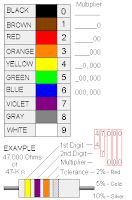Basically, all materials have resistive properties but some materials such as copper, silver, gold and metal materials generally have very little resistance. These materials deliver the electrical current very well, so-called conductors. The opposite of a conductive material, materials such as rubber, glass, carbon has a greater resistance restrain the flow of electrons and are called insulators. How the principle of conduction, described in an article on semiconductors.
The relationship between resistance, voltage, and current, can be summarized by the following law, which is known as Ohm's law:
The relationship between resistance, voltage, and current, can be summarized by the following law, which is known as Ohm's law:
Resistor is the basic electronic components used to limit the amount of current flowing in one circuit. As the name implies is a resistive resistor and generally made of carbon materials. From Ohms law is known, the resistance is inversely proportional to the amount of current flowing through it. Unit resistance of a resistor is called Ohm or represented by the symbol W (Omega). A common type of resistor is shaped tube with two feet of copper on the left and right. In the body there is formed a circle bracelet color code to identify the user greater ease without measuring the amount of resistance with ohmmeter. Color code is the manufacturing standards issued by EIA (Electronic Industries Association) as shown in the following table.






Post A Comment:
0 comments:
Post a Comment